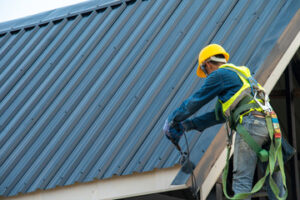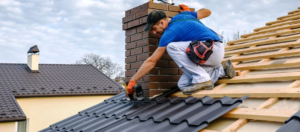Your roof is your shield against the elements. Without a well-maintained roof, everything else inside your home is on borrowed time.

The first step in any roof repair is to assess the damage. Observe the condition of shingles and gutters, flashing (thin metal pieces that prevent leaks at the junction of roof and wall), and other components like pipe collars.
A critical part of any roof system, flashing prevents water from seeping through seams and joints, where it can cause long-term damage to the roof structure and interior of a home. It is placed over the roofing underlayment (or beneath shingles) and along the edges of a roof, around any openings like chimneys, pipes, or vents.
A metal sheet, flashing can be shaped to fit the contours of different parts of a roof. For example, a channel flashing that’s shaped like a “U” to catch rainwater where a wall meets the edge of a roof, or apron flashing that covers the gap between a sloping roof and a vertical surface such as a dormer or chimney. Other types of flashing include flat ridge flashing that’s used to cover the crest of the roof, or barge capping flashing that’s box-shaped.
When flashing is damaged, it’s important to repair the damage promptly to avoid leaks and other problems that can lead to costly repairs. Often, the first step is to visually inspect a roof for signs of trouble. Then, if necessary, the damaged flashing should be removed and replaced.
It is essential to ensure that any new flashing pieces are secured with a strong sealant, such as roofing cement. Then, any nails or other hardware can be reattached if needed. The best way to secure a piece of flashing is to copy how the previous flashing was fixed, if possible. That will provide the strongest hold, since nailing can sometimes create weak points in a flashing.
The most common flashing material is galvanized steel, but aluminum and copper are also options. These choices offer differing levels of rust resistance and durability, as well as compatibility with the materials that comprise a building’s wall or roof cladding.
Once a flashing piece has been properly installed, it will keep water out of a roof through surface tension, gravity, and by directing rainfall away from potential infiltration points. It will also collect and drain pooling rainwater to help prevent leaks and puddles from forming. In addition, if the flashing is properly sealed and maintained it will also protect against the growth of toxic molds.
Shingles
The shingles that cover your roof create a protective barrier against moisture, sun and wind. Damaged shingles should be repaired as soon as possible to prevent rot and mold as well as water leaks that can cause significant interior damage and structural damage to the home. Signs that your shingles are damaged or in need of repair include water stains, sagging areas of the roof, discoloration and algae or moss growth.
Shingle damage can result from age, wear and tear, or weather conditions such as hail or high winds. A shingle’s lifespan is also affected by its exposure to sunlight and heat, which can cause it to become brittle or crack. Shingles can also be damaged by pests or animals, and by debris such as twigs, leaves and branches.
Many shingle problems, including small cracks and missing shingles, are relatively easy to repair. However, a do-it-yourselfer should consider his or her physical abilities and safety before attempting to perform a roof repair project. It is essential to have the correct ladder and safety equipment to climb on a shingle roof. Once on the roof, the individual should inspect the condition of the shingles and look for signs of water damage to the structure of the home.
Look for sagging spots, as these indicate that the roof is collapsing and can lead to rotting of the wood sheathing and foundation of the house. Also, check for dripping areas and bubbling in the walls or ceiling of your home. If you see a lot of granules in the gutter or in your yard, this indicates that the shingles are wearing out and should be replaced.
Also, examine the caulking around your window and door frames and the edges of the dormer walls for leaks. The caulking may be old or cracked, and it should be removed, resealed with a quality caulking material and re-nailed. Be sure to replace the nails that hold the bottom edge of the shingle, as these can also pull away from the flashing and cause water infiltration. Finally, it is a good idea to clean out cobwebs and debris from the soffits, recaulk areas where caulking has deteriorated, and paint or stain any corroded flashing or metal trim.
Built-up roofing (BUR)
If you’re a building owner, you might have heard about built-up roofing (BUR). You’ve also probably seen it in action: roofers spreading a gooey black substance with a mop on a flat or low-sloped roof. BUR is often textured with gravel, rock, or slag to create a durable, weather-resistant surface. But while a BUR can last up to 40 years, its lifespan depends on a number of factors, including climate and the contractor used for installation.
The first step in a BUR roofing installation is the base sheet. It is either nailed or fully adhered to the roof deck and serves as the foundation for the rest of the system. Some base sheets are self-adhesive, while others require the use of a special asphalt or roofing adhesive to bond with the roof.
Next, a layer of hot bitumen is spread over the base sheet, saturating it and forming a waterproofing barrier. Then a reinforcement fabric is placed over the bitumen layer to add strength and stability to the membrane. Finally, a surfacing layer is added, typically made of gravel, mineral granules, or a reflective coating.
Several benefits make built-up roofing a popular choice for commercial and industrial buildings. Its durability and longevity are key strengths, especially for buildings with low-sloped roofs where water ponding can occur. In addition, the multiple layers of bitumen and reinforcement provide excellent protection from wind and other weather elements.
One thing to keep in mind is that built-up roofing requires regular maintenance and inspections to ensure its proper function and to identify potential problems before they develop into leaks. Additionally, because it is made from petroleum-based materials, BUR roofing might not be a good option for building owners who are interested in environmentally friendly options. However, the material flexibility of BUR roofing easily adapts to changes in building movements and simple, economical installation options help save money and time. If you’re deciding on whether or not to repair or replace your existing roof, be sure to contact a GIDEON roof expert for an in-depth consultation. Our nationally-recognized roofing experts will provide a comprehensive assessment and a detailed recommendation.
Gutters
Gutters are a key part of a roof system and work to channel rainwater from the roof to downspouts, where it can be directed away from the house. Gutters prevent water from pooling on the roof and overflowing, which can damage siding, landscaping, and foundation walls. They also keep hydrostatic pressure from building up in the soil around the foundation, which can force walls to crack or even collapse.
Often, gutters can get clogged with leaves, twigs, and debris. When this happens, the gutters cannot properly direct rainwater from the roof. This can cause the shingles to buckle, drip edge, and erode, as well as push moisture back up under the shingles, where it can seep into the attic and down through interior walls.
Clogged gutters can also lead to the buildup of ice dams. When warm air in the attic melts roof snow, it trickles into the gutter and refreezes as it flows down the gutter. The resulting ice dam can force water up over the shingles and into the home. Gutters must be regularly cleaned to avoid these problems.
A residential roofer can help with gutter cleaning, but it is also a good idea to hire a professional gutter contractor who specializes in this work. Gutter specialists know how to inspect and repair both the gutter system and its interface with the roof, ensuring that the gutters are working as they should.
The condition of your roof and the state of your gutters are linked. Gutters prevent water from causing damage to your house, while a faulty roof can allow water to enter and damage the gutters, downspouts, and fascia boards. To avoid these costly repairs, it is important to maintain your gutters, and to have a reliable roofer perform regular maintenance and inspections. If you are considering a roof replacement, it may be more practical to have the gutters replaced at the same time, as this can minimize future costs and headaches. Depending on your budget, it is also possible to finance gutter replacement or repair. A mortgage broker can help you find the right lender and obtain a loan that works for your situation.
